Technics' New SL-1200GR2 Could Be the Lineup's "Sweetest Spot"
smooth sailing and detail too!
Can you name an audio product that for more than fifty years has been manufactured and sold unchanged? Technics iconic SL-1200 isn’t one of them. Yes, today’s SL-1200 turntable series looks like the original SL-1200 introduced back in 1972 but looks can be deceiving. Nonetheless, YouTube comments confirm that many SL-1200 enthusiasts continue to believe that what they bought in 1972 is equal to or better than what Technics produces today, partly because most current SL-1200s are made in Malaysia.
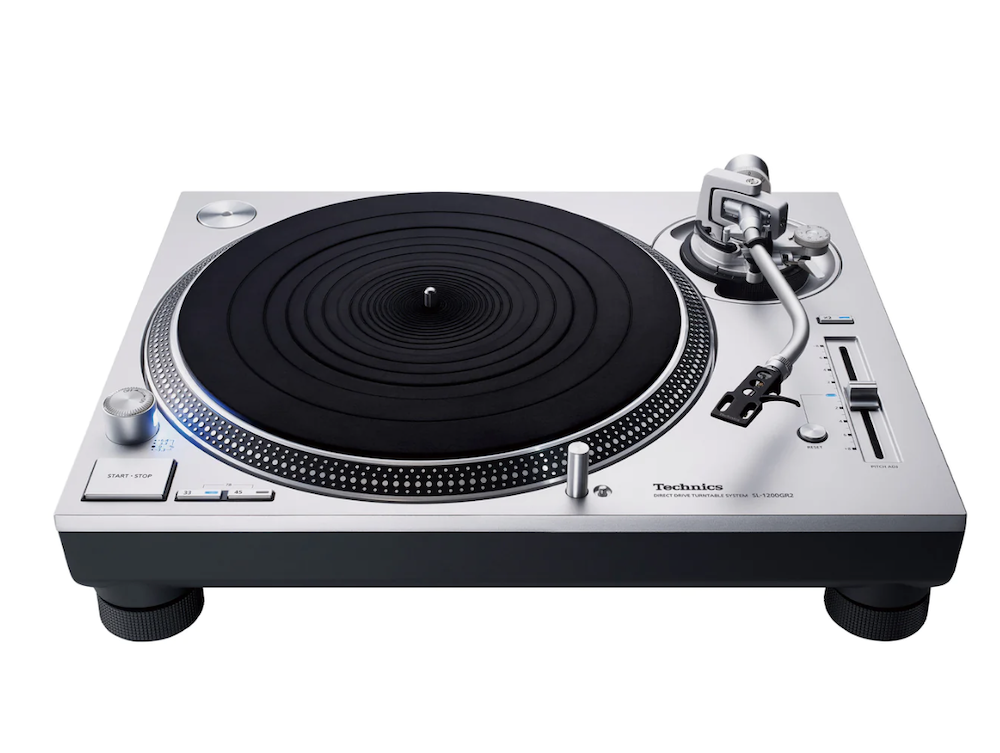 A more "official" portrait
A more "official" portrait
They think “Made in Japan” equals better. How far we’ve come from the days when “Made in Japan” was considered derogatory—not many young people know about that.
You can’t blame Technics (pronounced “Techneeks”, not “Techniks”!) for continuing to use a fifty year old industrial design. It’s one of the most recognized turntables looks ever. It’s iconic. It’s been copied by others, but that shouldn’t bother Technics: the cliché is true that imitation is the sincerest form of flattery. Every fake SL-1200 is a shout out to the real thing.
The new $2199.99 Technics SL-1200GR2
There’s an excellent history of the Technics SL-1200 on the Audio Cognoscenti website written by Kevin Barrett of KAB Electroacoustics . Recently, Kevin, who I don’t know personally, asked if I could find a quote from my former Stereophile editor John Atkinson, which I did, and you’ll see it in the body of Kevin’s excellent historical and technical reporting in is post, which is the source of some of what’s below.
Be mindful that Kevin appears to be in the “if it can’t be measured it doesn’t exist” camp, and if it can be measured, the measurement tells all. If you read through what he’s written, as he goes through the improvements Technics has made to its design, he acknowledges the forward steps but seems skeptical that any of them could possibly make a sonic difference based upon the measurements and what they mean. In fact, the piece cited above, if I read it correctly, was posted to prove that most if not all of these platter rotation improvements did nothing to improve sonic performance.
Of course, based on experience, I don’t believe everything we can hear has been measured. In designing the direct drive OMA K3 turntable ($300,000+), blind listening panels were employed and the engineer in charge, Richard Krebs (he’s an industrial hydraulics engineer, turntable design is a side career) was “astonished” to find that minute changes in the motor controller programming produced audible changes that in blind tests the listening panel could reliably identify—“down to arc seconds of rotation”. There are 1,296,000 arc seconds in one rotation. Yet in this realm, no measurements exist. At least for now.
Over the years Technics has made great strides in improving the 3 phase brushless DC direct drive motor design, and perhaps equally importantly, motor control performance. In the early days audiophiles complained about hearing “cogging”, which the “measurements tell you everything” people insisted was inaudible because of the low frequency at which it appears. Based on what he’s written, that’s what I gleaned was and is Mr. Barrett’s position.
Nonetheless, that and the reputed “hunting and pecking” as the motor continually sought to lock onto the reference motor control frequency (I’m simplifying) is what listeners claim they heard. The earliest SL-1200s used a motor coil winding that produced a feedback voltage and a simple R/C network to convert it into a DC voltage that the system would compare to a reference voltage, which would maintain speed. These turntables measured well, and their fans said the measurement proved near perfection so end of story.
Technics developed a series of motor controller upgrades over the decades that produced both measured, (and listeners claim) sonic improvements as well, including in 1979 a Quartz Phase Locked Motor and controller system. Without getting into too much detail for the purposes of our review, the control signal allows the system to sense the actual platter position and the generated signal is compared to a quartz crystal reference and the two are kept “in phase” via a PLL (“phase lock loop) circuit. This is obviously measurably better and PLL circuits have been used for decades. Nonetheless, the “measurements tell all” people insist that while this is a different methodology, the results are close enough for there to be no audible difference based on their measurements and their interpretation of same.
Whatever drive system non-linearities exist in a belt drive turntable are filtered out by the mechanical system—not that belt drive systems don’t have their own easily audible issues, though many (if not most) listeners find some of those less objectionable. Not so with direct drive where there are no mechanical filters, so such systems are extremely sensitive to these “non-linearities” measured or otherwise. Speaking personally, some of the early direct drive turntables made me not want to listen after a while.
Jump cut to today (bypassing numerous Technics motor and controller improvements) and we have the new GR2 series. I’ll quote the press release rather than regurgitate it in my own words, though it repeats some of what I wrote above:
“The motor control signal for the new SL-1200GR2/SL-1210GR2 is a huge leap in performance in comparison with earlier versions. Looking back to the 1970s, the motor control sine wave signal was generated by an analogue RF oscillator, the precision of which left room for smoother rotation. After the revival of the Technics SL-1200 turntable in 2016, the new SL-1200GAE – along with the much-improved motor by an iron-coreless stator – inherited a new motor control based on PWM (pulse width modulation) for D/A conversion, using a micro controller including a sine-wave ROM. This added remarkable impact on the whole rotational precision and helped achieve lower motor vibrations. However, despite this approach, the sine wave for motor control was still not 100% accurate.
“Therefore, in the new GR2, the motor control signal is generated by the usage of a PWM signal generated by ΔΣ (Delta Sigma) Modulation, a method of high precision 1bit D/A conversion which is part of the signal procession in Technics’ full-digital amplifiers that use our proprietary technology JENO Engine. By this approach, consequently given the name ΔΣ-Drive (Delta Sigma Drive), a perfect sine wave is generated, and motor vibrations are radically reduced. This has a significant impact especially on the frequency range where the motor vibrations overlap with the natural resonance of the tonearm/pickup cartridge combination. Thus, the tracking precision is drastically improved. The result is a stunning signal precision with an accurate sound stage, superb imaging, and a very low noise floor.
“In combination with the rotation feedback system based on speed detection by the usage of a frequency generator (FG) which works on magnetic power generation, the rotational speed precision of the new GR2 type is exceptional.
“Along with the motor control, the general power supply has also been the focus of engineering. The new Multi-stage Silent Power Supply of the SL-1200GR2/SL-1210GR2 is a combination of a low-noise, high-speed power supply working at over 100kHz and a noise canceling circuit inherited from our reference class turntable SL-1000R ($11,000), cancelling remaining noise by injecting the reversed-phase current of the actual noise. By this method, a very low noise floor is achieved, enabling exceptional signal-to-noise ratio, improving the overall signal performance.”
I find this level of technical detail far more persuasive than the usual audiophile hyperbolic drivel, don’t you—whether you think these differences can produce an audible difference is a different tale.
Technics claims that the lower vibrational energy produced by this new motor control scheme plus the power supply upgrade improves cartridge tracking along with motor control and that makes sense. Less vibrational energy transmitted from the system to the cartridge, should improve tracking.
Mechanically, Technics retains in the GR2 most of what the predecessor GR offered: a double layer bottom chassis of aluminum and BMC (Bulk Moulding Compound), the combination of which is said to produce high resistance to vibrations, a 2-layered platter made of aluminum and dampened with heavy-weight rubber and the also iconic S-shaped 9” aluminum tonearm and the insulator feet. Technics supplies a new headshell spacer for low profile cartridges.
Cosmetics have been subtly improved. If you buy a silver one, it’s all silver. The original GR2 had some black trim. If you buy a black one, it’s all black including the tonearm. The turntable's "fit and finish" is extremely high.
The Familiar Feature Set
There’s little point in belaboring the turntable’s familiar feature set other than to list what it does and what’s included: variable pitch control, 33 1/3, 45 and 78 rpm speed, built-in strobe, adjustable VTA/SRA using the precise, knurled rotating arm platform , the cool pop-up cueing light —a feature not to be sneezed at especially by audiophiles who prefer listening in the dark— and strobe markings on the platter and integrated strobe light.
New and Improved Packaging
Technics’ new “green” packaging eliminates the styrofoam side pieces, which is nice but more important is a new cardboard “ramp” built into the packaging. Access to the IEC A.C. and RCA signal jacks partially tucked away under the base has always been problematic in these turntables. Some frustrated consumers tilt the ‘table at an angle to gain access and in the process damage or break the flexible isolation feet that do not take kindly to being bent at an angle. The new integrated cardboard ramp allows you to set the ‘table safely at an angle for easier access to the jacks. Good idea!
Set-up and Use
First up of course was to check level and if necessary to adjust height using the isolation feet. No adjustment necessary but that’s job number one. My original choice was to review the GR2 “as delivered”. In other words, to use the supplied grooved rubber mat, interconnect cable and power cord and to not adjust the torque switch, which is factory-set to “high”. That’s how most buyers will initially use the GR2, though from previous experience I know that a mat change—even an A.C. power cord change—will make easily audible improvements but I figured that’s for buyers to discover.
Technics does not supply a cartridge so I began with the ubiquitous Ortofon 2M Red, then I switched to a vintage Cartridge Man moving iron type cartridge that looks as if it started life as a Grado and finally I swapped it out for the remarkable new SETO-HORI REMODEL HO MC from JICO, which is an integrated cartridge/headshell that plugs into the Technics arm, or any similarly terminated arm. It’s quite a heavy assemblage (about 27.62g) and costly ($4000) but sure looks beautiful. I’m not sure of how many buyers of turntables costing $2000 are added a $4000 cartridge/headshell combination. Probably none but you never know!
The weight required the auxiliary counterweight and even then, the main counterweight had to be placed well back on the counterweight stub. You can adjust the overhang in this cartridge/headshell but plugged in as delivered into the 230mm effective length Technics arm it conformed to Löfgren A geometry. After hearing that cartridge transform the sound, I felt obligated to do some mat experiments, but I didn’t change power cord! I ended up with the 5MM tall grey Funk Firm Achromat
Sound
Do I have here an original SL-1200GR to compare to the GR2? Do I have an older SL-1200 here? Do I have the more costly 1200G ($4299)? No. I have none of those here so I can’t do the comparisons, but does that really matter? Not to the people who think all turntables sound the same or that all SL-1200s produced over the past fifty years sound the same, and if you do a bit of searching, you’ll find lots of those people! They don’t think even the magnesium arm tube on the SL-1200G or its precision-balanced platter can possibly make a difference. They are wrong there, especially as relates to the tonearm!
The biggest issue I had with this turntable was the lack of isolation despite the supposed “isolation” feet. There was very little isolation. Tapping the platform on which it sat (a Stillpoints SS rack) produced very strong feedback into the ‘table and tapping on the plinth was worse still. That was surprising. Placing it atop an IsoAcoustics zaZen 1 turntable isolation stand ($159.99) helped a bit, though the ‘table’s 25.4 pounds is just over the stand’s max 25 pound capacity but it’s the only one I had on hand. The zaZen II ups the capacity to 40 lbs and is probably a better choice. Still, I was surprised by the “liveliness” of the plinth, though of course an impulse “tap test” is not necessarily a leading indicator of how well the ‘table is isolated from musical feedback, or even from “foot falls” (of which there are none here because my floor is concrete).
The GR2’s measured performance using the Shaknspin app was exceptional. Wow: 0.05/Flutter: 0.02. W&F RMS: 0.02/Jitter% 0.02. Those are some mighty good numbers and while this device isn't "laboratory grade", it does provide a baseline comparison with other turntables measured with the same device.
The 2M Red gets the basic job done but this turntable’s sonic performance unlocks and opens as you upgrade the cartridge. That’s true of most turntables up to the point where the cartridge’s performance overwhelms the turntable’s mechanical abilities if any.
Compare the SL-1200GR2’s tonearm with what’s supplied with most circa $2000 turntables and mechanically there really isn’t much of a comparison, though rigidity takes a bit of hit in exchange for the removable headshell and there are three signal breaks between the cartridge pins and the RCA plugs. If easy cartridge swaps are among your needs, the plug in headshell will be on your “must have” list. The locking VTA/SRA adjustment ring that raises and lowers the platform directly beneath the arm helps assure that you’re not shifting azimuth as you adjust up and down, though of course this arm doesn’t have actual azimuth adjustability. Still, the arm’s construction and the feel of tight bearings gives confidence that it can handle any cartridge (where the arm/cartridge resonant frequency falls between 8-12Hz)
Technics’ Bill Voss suggested leaving the torque setting at factory “max” setting so I did but buyers should feel free to experiment. Lower the torque and invariably the sound will soften somewhat, reducing what some rightly or wrongly feel is a “mechanical” quality produced by direct drive turntables. It also tends to lengthen decay and add (or unlock”) instrumental suppleness and texture, but is that on the record or an additive quality produced by lowering torque? And does that really matter (no). It’s what you prefer. I prefer adding those quality via the cartridge.
With any of the auditioned cartridges the ‘table’s sound conformed to those excellent measurements, meaning the presentation was rhythmically agile, with precise transient performance in the “power and punch” ways direct drive and idler wheel drive often best belt drive. The idler price for all the drive you get, is usually added noise about which there’s nothing you can do. This ‘table produced dark backdrops.
The table’s bottom end will not impress those who like enveloping warmth—and that’s true of my costly reference ‘table. If the bass isn’t in the grooves, it won’t come out of the speakers. But if there is deep bass on the record, it will exit the speakers with impressive attack, natural sustain and precision decay—and with even greater authority if you replace the grooved rubber mat with a Funk Firm Achromat
If you watched and listened to the video posted on the TrackingAngle YouTube channel comparing the excellent Air Force III Premium S turntable to the OMA K3, you get this difference. That said, the reaction under the video was fascinating, with almost an equal amount preferring one or the other.
With The Cartridge Man Music Maker MK III Moving Iron Cartridge
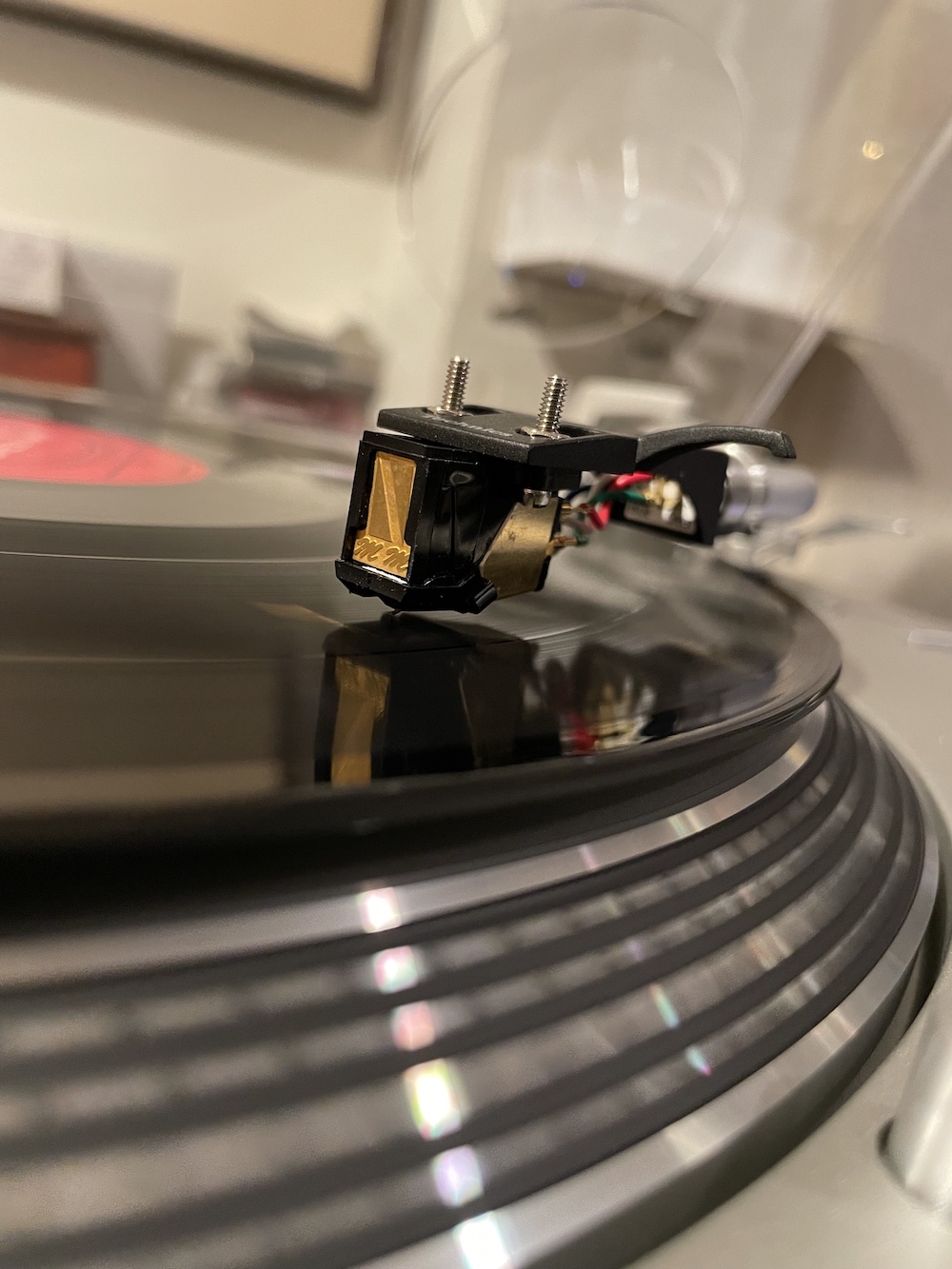 This discontinued 4mV output moving iron cartridge sold for $1,194.99. It always struck me as being as timbrally neutral as a transducer can be: full-bodied and generous in that neutrality. I’ve not set it up in years but now that I can actually measure the response using the CH Precision P10’s “loading wizard” (the older P1 had it as well) I was able to ascertain that yes, when loaded at 43kOhms the response was as flat as you’ll see in a cartridge, with no rising high end character found in many moving coil designs. That reminds me! I need to run the V15VxMR and see what it does.
This discontinued 4mV output moving iron cartridge sold for $1,194.99. It always struck me as being as timbrally neutral as a transducer can be: full-bodied and generous in that neutrality. I’ve not set it up in years but now that I can actually measure the response using the CH Precision P10’s “loading wizard” (the older P1 had it as well) I was able to ascertain that yes, when loaded at 43kOhms the response was as flat as you’ll see in a cartridge, with no rising high end character found in many moving coil designs. That reminds me! I need to run the V15VxMR and see what it does.
The Music Maker MKIII/SL-1200GR2 combo into a $76,000 phono preamp made some seriously impressive music. Few listening blind would imagine an under $2400 “front end” making this kind of sound.
I played the Rhino High Fidelity edition of Coltrane Sound, which I’ve been meaning to review for months now and Coltrane’s saxophone had all of the three-dimensional roundness and reedy texture you’d want, appearing between the speakers. “Body And Soul” was as enjoyable and well-presented as you could want—even Tyner’s piano had body and warmth and it’s not exactly well-recorded here or on My Favorite Things put to tape during the same pretty incredible session. This combo had a rhythmic and timbral “togetherness” that forced me to play it on the big costly rig to find out what, if anything was missing, or what I might be giving up to get more there.
But first I played a new AAA reissue of Neil Young’s Time Fades Away a live album he has hated for decades but decided it was time for a reissue. I’ve always liked it. Is it okay to like an album Neil hates? I have 4 original pressings and a U.K. original too. This new one cut from tape by Chris Bellman and pressed at GZ on transparent vinyl beats them all. It’s got one of Neil’s most brutally honest autobiographical tunes, “Don’t Be Denied”. The sound of this reissue is so transparent, I kept being startled by the musicians hiding behind the speakers.
The Cartridge Man/SL-1200GR2 combo didn’t curtail any of that but when I switched to the big rig mostly what was there and not here was dynamic slam and insistence, plus some transparency, but honestly, many of you reading this might hear what I’m hearing and say “I’ll take that less costly assemblage both because I like the sound better and it leaves me money to buy a really nice car!” You’d also want the CH P10, which costs $76,000 and worth it!
The SETO-HORI Plug in Headshell
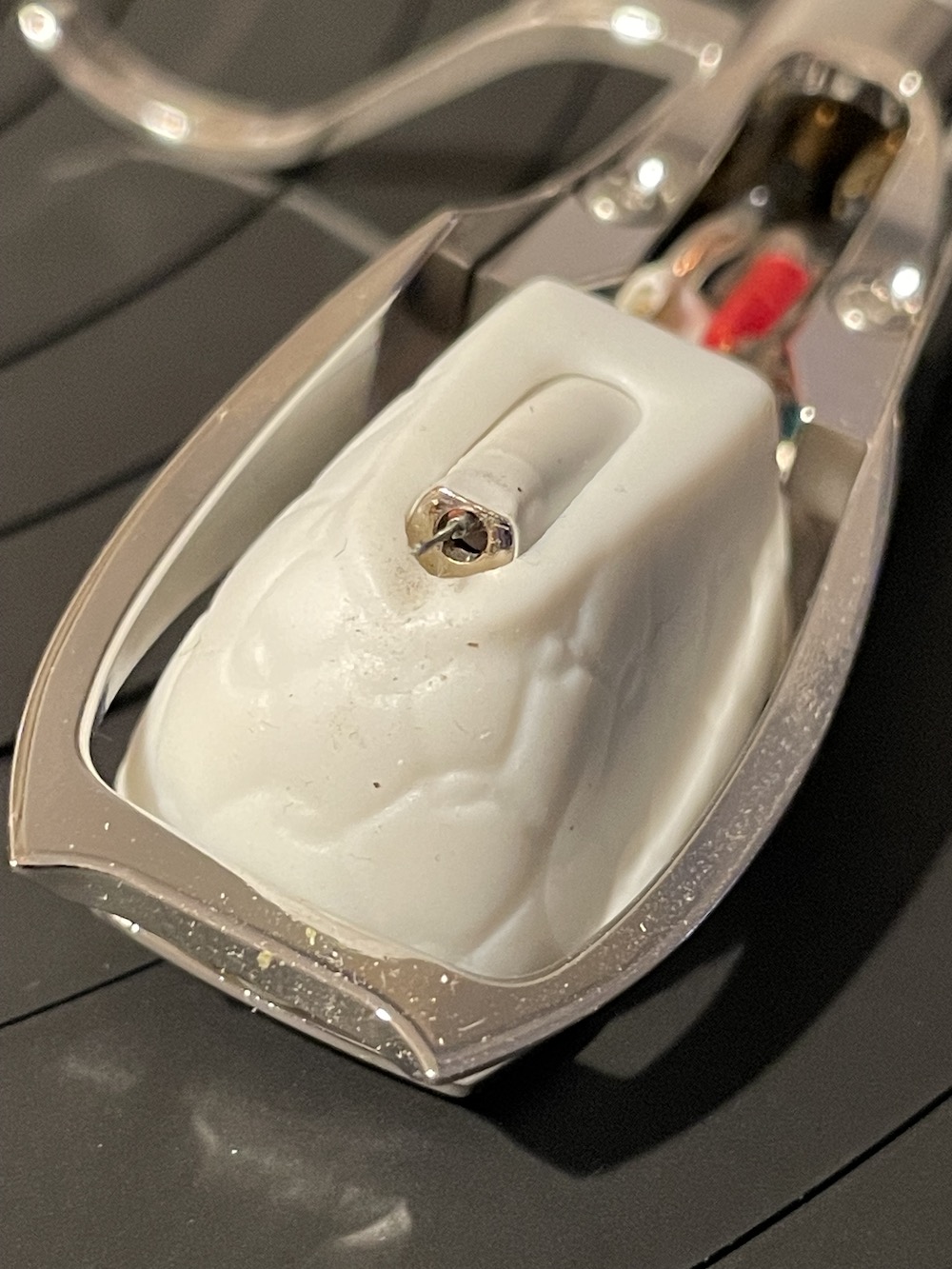 The JICO manufactured SETO-HORI is a high output (2mV) moving coil cartridge built into a piece of gleaming jewelry-like aluminum and copper alloy headshell 5 axis CNC machined to produce a body with “uniform vibration characteristics” according to JICO. The cartridge body is a ceramic material.
The JICO manufactured SETO-HORI is a high output (2mV) moving coil cartridge built into a piece of gleaming jewelry-like aluminum and copper alloy headshell 5 axis CNC machined to produce a body with “uniform vibration characteristics” according to JICO. The cartridge body is a ceramic material.
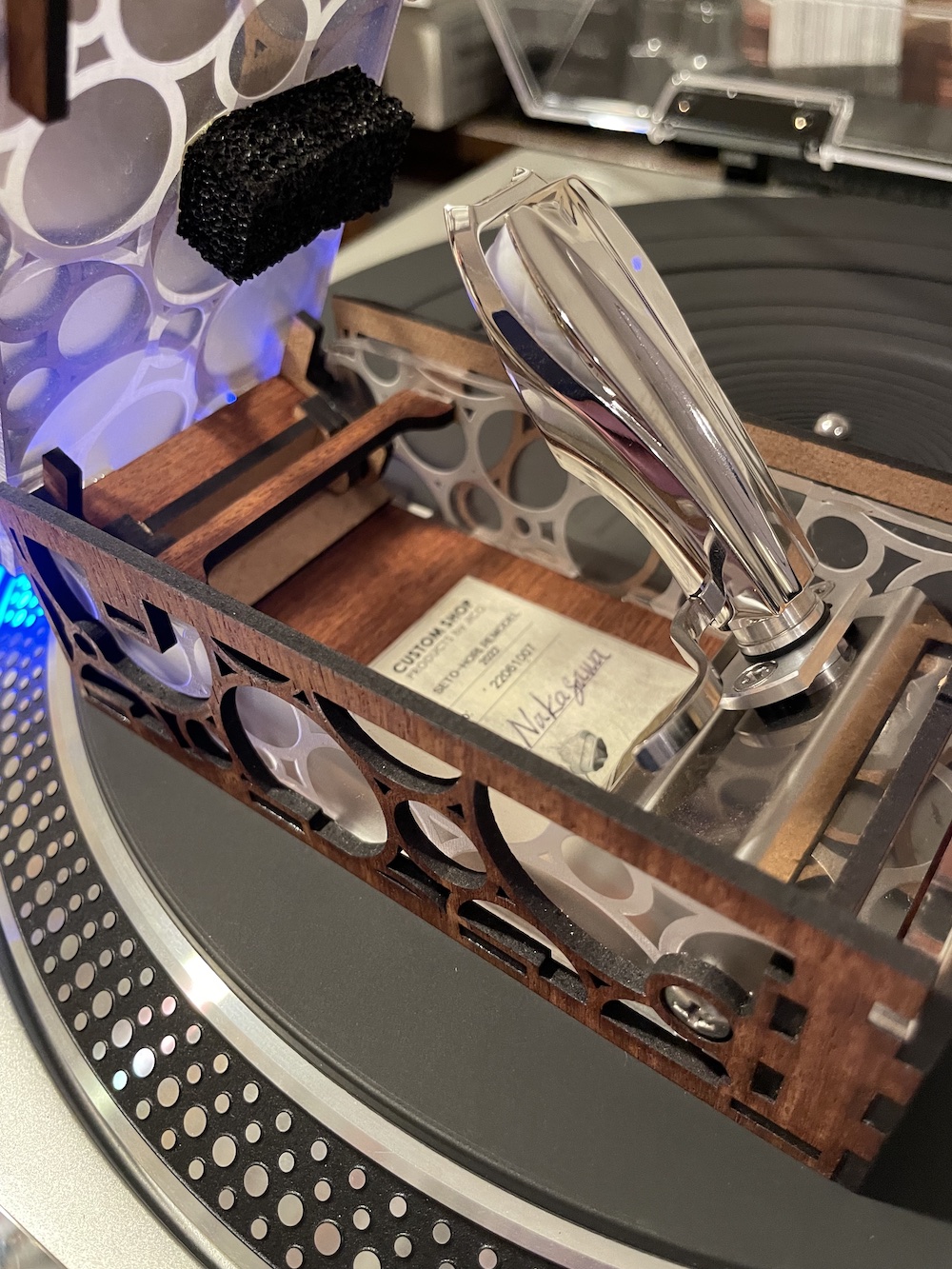
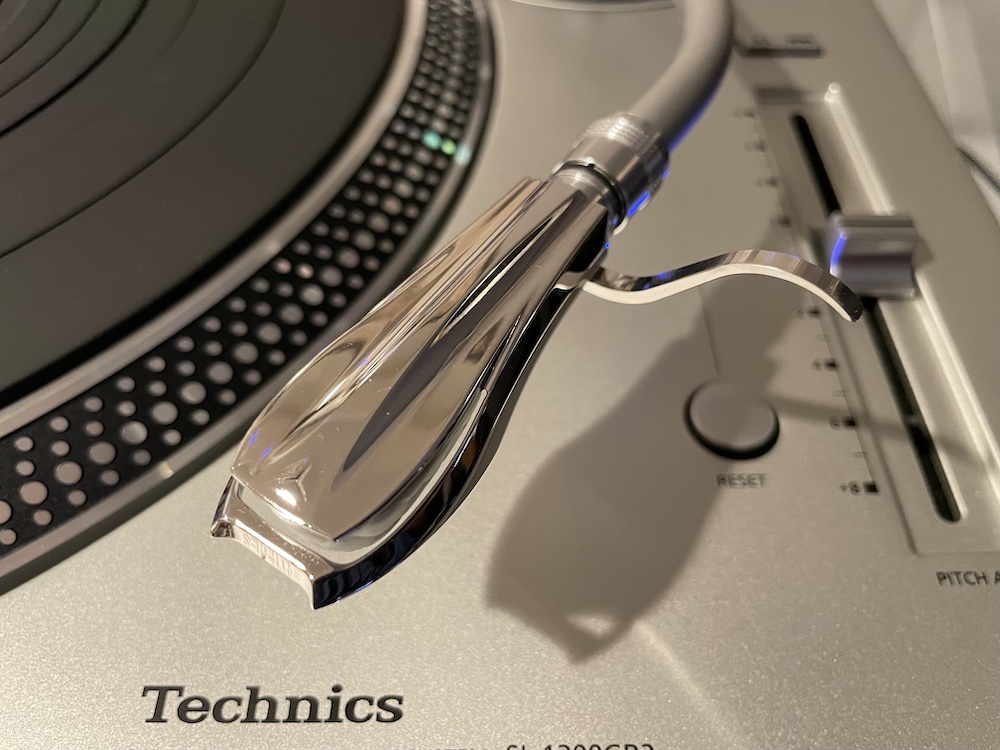
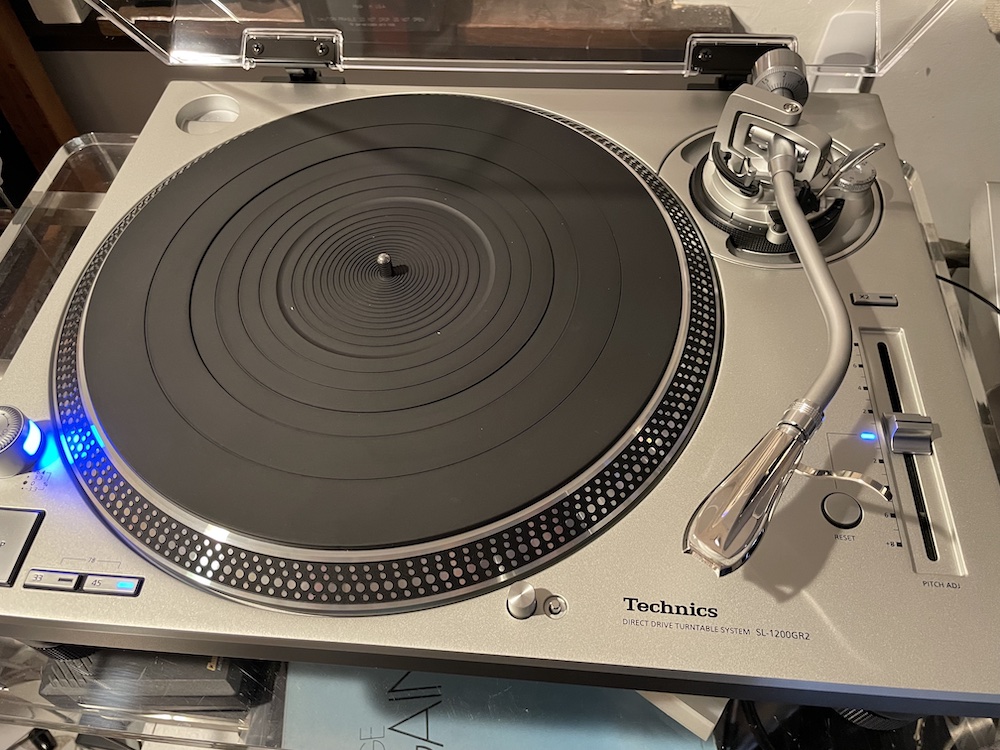 Here’s how JICO describes the assemblage on its website:
Here’s how JICO describes the assemblage on its website:
Micro Ridge + Boron Cantilever
The “Micro Ridge Diamond Tip” has a polyhedral shape and a life span that is more than three times that of a standard record stylus.
Cartridge Section
In addition to its insulating properties, low permeability and high coercive force, the ceramic case provides the most comprehensive protection of the fine magnetic field characteristics within the MC cartridge.
Headshell Section
The material is an alloy of aluminum and copper that was completely machined by a 5-axis machine to create a single-piece body with uniform vibration characteristics.
In order to accurately follow the pivot movement characteristics of the tonearm, the headshell and cartridge body have a vertical center of gravity configured at the center of the tone arm.
By balancing the tone arm with a body weight of 26.8g, the amplitude of vertical movement is kept to a low frequency, minimizing stress on the stylus suspension.
An electromagnetic noise-absorbing sheet with a permeability of 10μ is inserted between the cartridge and the headshell to counteract the changing characteristics of the magnetic properties.
Lead Wire
The lead wire of the cartridge is made by Koike Analog Factory.
The positive side of the 29mm lead wire is Oyaide 102SSC 0.28mm 3-pair set.
The negative side is a Hitachi OFC 0.18mm 8-pair set.
Provides full support for high-resolution sound.
[SETO-HORI REMODEL Product
Specifications] Model: MC
Impedance: 130Ω / 1kHz
Output voltage: 2.0mV / 1kHz
Output balance: <1.5dB / 1kHz
Channel separation: 25dB / 1kHz
Stylus pressure: 2 ± 0.2 g
Frequency characteristics: 15-32,000Hz
Load resistance: 47KΩ
DC resistance: 130Ω
Cantilever: Boron
Stylus tip: Microridge
Static compliance: 18 × 10-6cm / dyne
Dynamic compliance: 10 × 10-6cm / dyne
Right angle tracking angle: 26 °
Tracking ability: 70μm / 2gr
Mass: Approximately 27.5g
Cartridge housing: Ceramic (Seto)
Okay, it costs $4000, but it is a piece of work physically and sonically! The sound produced is best described as “linear luxury”. No obvious lumps or bumps to the frequency response and not at all soft or boring yet there was a smoothness and caressing quality to everything it touched, plus the detail you’d expect from a Boron cantilever/microridge stylus profile.
I’m golng to do a SETO-HORI REMODEL video review to show this and play a few tracks through this turntable so stay tuned for that. I think this review has gone on too long so I’ll just end this section by saying I don’t think this $2200 turntable dampened any of the SETO-HORI’s sonic glory—at least it made obvious what the designers were trying to achieve. Unfortunately, I have nothing else to plug it into.
Conclusion
This’ll sound like B.S., but I don’t care: when I went to the introduction of the SL-1200GR2 at a small event near Panasonic's Newark, NJ headquarters and without any pre-digested corporate hokum from Technics’ Bill Voss, if anyone had asked me what I heard I’d say a “smoothness and serenity” I wasn’t used to hearing coming from these SL-1200s I’d heard and reviewed through the years, though without the $4300 SL-1200G on hand who can be sure of why I was hearing what I heard. Could be the weather.
And that’s the problem here too. I don’t have the full lineup here to compare to the 1200GR2 so all I can do is tell you how it sounded and I hope I gave you some idea without running through a dozen more records because I’m getting kind of tired of that review paradigm.
If I have to sum up this new turntable, I’d say it’s the new “sweet spot” in the SL-1200 lineup. Perhaps it’s not quite up to the performance of the more costly unit with the magnesium tonearm and more precisely balanced platter but I can’t say for sure.
But at half the price, it’s surely not half as good! So before you buy any circa $2000 turntable, give this one a spin and do it with a really good cartridge, an Achromat or some other not rubber mat, and do a few things I didn’t do before you decide if you like it: try a different power cord and a set of your favorite phono cables.
Or maybe all SL-1200s manufactured over the past fifty years sound equally good and if you’ve got one of those you’re done! But I don't believe that for an arc second.
Specifications
General | |
Power Supply | AC 110-240 V, 60 Hz |
Power Consumption | 11 W, Approx. 0.3 W (OFF) |
Dimensions (W x H x D) | 453 x 173 x 372 mm (17-27/32 × 6-13/16 × 14-21/32 inch) |
Weight | Approx. 11.5 kg (Approx. 25.35lbs) |
Accessories | Turntable, Turntable sheet, Dust cover, EP record adaptor, Balance weight, Auxiliary weight, Cartridge spacer Head shell, Overhang gauge, Screw set for cartridge, PHONO cable, PHONO earth lead, AC power supply cord, Owner's Manual |
Operating humidity range | 35% to 80% RH (no condensation) |
Terminals | |
Audio Output | PHONO (Pin Jack) x 1, EARTH TERMINAL x 1 |
Tonearm Section | |
Type | Static Balance |
Effective Length | 230 mm (9-1/16") |
Overhang | 15 mm (19/32") |
Tracking Error Angle | Within 2° 32' (at the outer groove of 30 cm record), Within 0° 32' (at the inner groove of 30 cm record) |
Offset Angle | 22° |
Arm-height Adjustment Range | 0 - 6 mm |
Stylus Pressure Adjustment Range | 0 - 4 g (Direct Reading) |
Head Shell Weight | Approx. 7.6 g |
Applicable Cartridge Weight Range | (without auxiliary weight) 5.6 - 12.0 g 14.3 - 20.7 g (including head shell) (with auxiliary weight) 10.0 - 16.4 g 18.7 - 25.1 g (including head shell) |
Cartridge Mounting Dimension | 12.7 mm (1/2") interval |
Head Shell Terminal Lug | 1.2 mmφ 4-pin terminal lug |
Turntable Section | |
Type | Direct Drive Turntable |
Motor | Brushless DC Motor |
Turntable Speeds | 33-1/3, 45 and 78 r/min |
Adjust Range | ±8 %, ±16 % |
Starting Torque | 2.2 kg-cm |
Build-up Characteristics | 0.7 s. from Standstill to 33-1/3 r/min |
Braking System | Electronic Brake |
Wow And Flutter | 0.025 % W.R.M.S. |
Rumble | 78 dB (IEC 98A weighted) |
Turntable Platter | Aluminum diecast, Diameter : 332 mm, Weight : Approx. 2.5 kg (5.51 lb) (Including rubber sheet) |


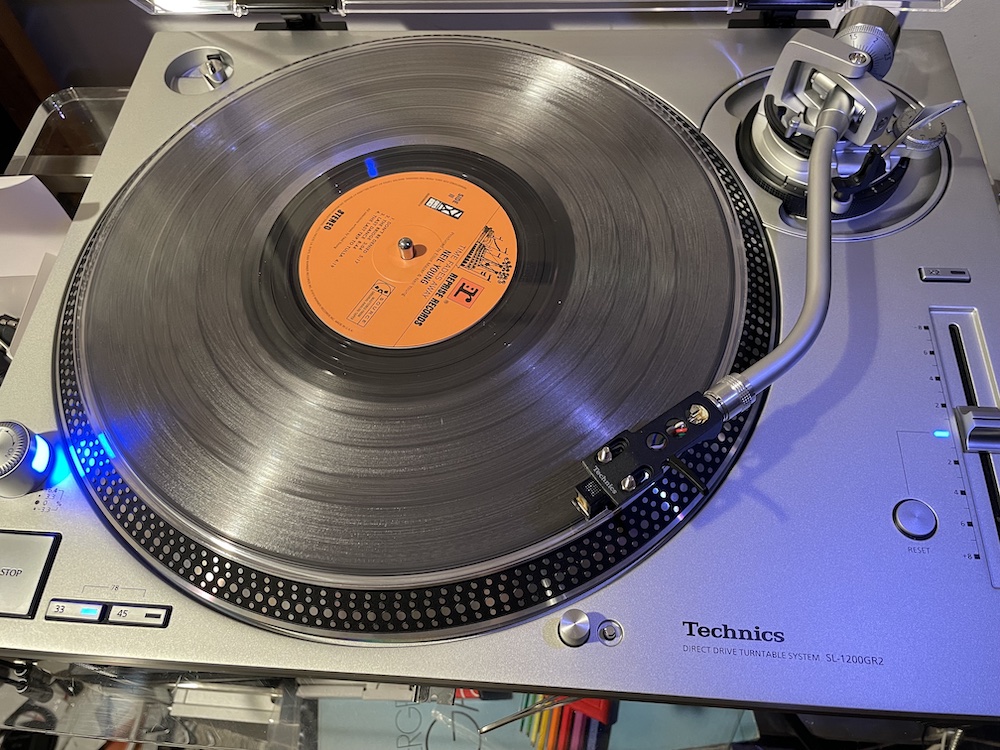







































.png)








